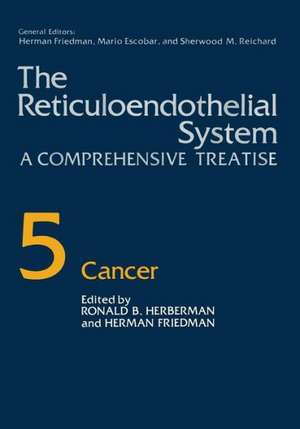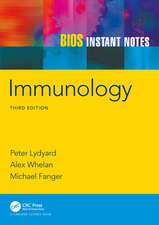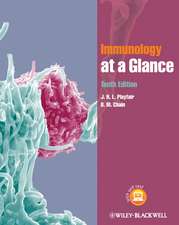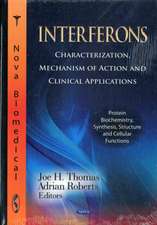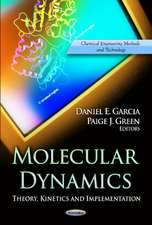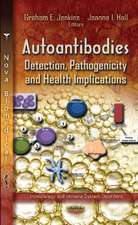The Reticuloendothelial System: A Comprehensive Treatise Volume 5 Cancer
Editat de Herman Friedmanen Limba Engleză Paperback – 22 mar 2012
Preț: 725.42 lei
Preț vechi: 763.60 lei
-5% Nou
Puncte Express: 1088
Preț estimativ în valută:
138.81€ • 145.29$ • 115.53£
138.81€ • 145.29$ • 115.53£
Carte tipărită la comandă
Livrare economică 31 martie-14 aprilie
Preluare comenzi: 021 569.72.76
Specificații
ISBN-13: 9781468445107
ISBN-10: 1468445103
Pagini: 380
Ilustrații: XX, 356 p.
Dimensiuni: 178 x 254 x 20 mm
Greutate: 0.66 kg
Ediția:Softcover reprint of the original 1st ed. 1983
Editura: Springer Us
Colecția Springer
Locul publicării:New York, NY, United States
ISBN-10: 1468445103
Pagini: 380
Ilustrații: XX, 356 p.
Dimensiuni: 178 x 254 x 20 mm
Greutate: 0.66 kg
Ediția:Softcover reprint of the original 1st ed. 1983
Editura: Springer Us
Colecția Springer
Locul publicării:New York, NY, United States
Public țintă
ResearchCuprins
1. Neoplasms of the Mononuclear Phagocyte System.- 1. Acute Myelomonocytic Leukemia (AMML, French-American-British Classification, FAB-M4).- 2. Acute Monocytic Leukemia (AMoL, FAB-M5).- 3. Chronic Myelomonocytic Leukemia (CMML).- 4. Malignant Histiocytoses, without Langerhans Granules.- 5. Malignant Histiocytoses, with Langerhans Granules.- 6. Proliferations of MPS, Not Proven to Be Malignant Neoplasms.- 7. Other Neoplasms Considered to Be of MPS Origin.- 8. Differential Diagnosis.- References.- 2. Lymphatic Metastasis of Neoplasms.- 1. Lymph Node Metastasis in Human Cancer.- 2. Invasion and Metastasis.- 3. The Normal Lymphatic Vessel and Its Cellular Content.- 4. Experimental Lymphatic Metastasis.- 5. Penetration of the Lymphatic Capillary.- 6. Cells in Lymph-Draining Tumors.- 7. Reaction in the Draining Node.- 8. Barrier Function of Lymph Nodes—Tumor Cell Killing.- 9. Chemotherapy and Immunotherapy of Lymphatic Metastasis.- References.- 3. Control of Tumors by the RES.- 1. Introduction.- 2. The RES in Development of Cancer.- 3. The RES in Progression of Cancer.- 4. Mechanisms Mediating Antineoplastic Activity of the RES.- 5. Factors Affecting Antineoplastic Activities of the RES.- 6. Modulation of the RES and Cancer.- 7. The RES and the Concept of Immune Surveillance.- 8. Conclusions.- References.- 4. Activities of Macrophages Within and Peripheral to the Tumor Mass.- 1. Introduction.- 2. Mechanisms Controlling Accumulation of TAM.- 3. Peripheral Blood Monocytes, TAM, and Heterogeneity.- 4. Tumor Immunogenicity, Host Immunity, and TAM.- 5. Macrophages and Intratumor Functions.- 6. Conclusions.- References.- 5. Stimulation of the RES and Control of Cancer Metastasis.- 1. The Pathogenesis of Cancer Metastasis.- 2. Host Immunity and Metastasis.- 3. Rationale forControl of Micrometastasis by Activated Cytotoxic Macrophages.- 4. Activation of Macrophages by Agents Encapsulated within Liposomes.- References.- 6. Neoplasia and Mononuclear Phagocyte Function.- 1. Introduction.- 2. Role of Macrophages in Tumor Growth.- 3. Increase in Monocyte/Macrophage Numbers in Tumor-Bearing Animals.- 4. Enhancement of Macrophage Migration by Tumor Factors.- 5. Chemotactic Factor Inactivators Associated with Neoplasia.- 6. Monocyte/Macrophage Migratory Dysfunction in Tumor-Bearing Hosts: Evidence for the Presence of Tumor-Associated Inhibitory Factors.- 7. Isolation and Characterization of Inhibitors of Mononuclear Phagocyte Function Associated with Neoplasia.- 8. Summary.- References.- 7. Suppressor Cells and Cancer: Inhibition of Immune Functions by Macrophages.- 1. Introduction.- 2. Approaches for the Demonstration of Suppressor Macrophages.- 3. Suppression of Lymphoproliferative Responses.- 4. Suppression of the Generation of Cytotoxic T Lymphocytes.- 5. Suppression of Antibody Responses.- 6. Suppression of Lymphokine Production.- 7. Suppression of NK Cell Activity.- 8. Suppressor Macrophages in Normal as Well as in Tumor-Bearing Individuals.- 9. Do Macrophages Inhibit Every Aspect of the Immune Response?.- 10. Generation of Suppressor Macrophages.- 11. In Vivo Role of Suppressor Macrophages.- 12. Summary and Concluding Remarks.- References.- 8. Modulation of Mononuclear Phagocytes by Cancer Chemotherapeutic Agents.- 1. Introduction.- 2. Effects of Chemotherapeutic Agents on Mononuclear Phagocytes.- 3. Antitumor Efficacy and Modulation of Mononuclear Phagocytes.- 4. Concluding Remarks.- References.- 9. Natural Killer Cells and Other Effector Cells, and Their Roles in Resistance against Cancer.- 1. Introduction.- 2. Effector Mechanisms That May Be Involved in Resistance against Tumor Growth.- 3. Is the Immune Surveillance Hypothesis Valid?.- 4. Use of Assays for Monitoring of Immunotherapy Trials.- 5. Concluding Remarks.- References.- 10. Immunosuppressive Factors Produced by Tumors and Their Effects on the RES.- 1. Tumor-Produced Suppressor Factors.- 2. Blocking Factors—Immune Complexes.- 3. Tumor and Fetal Tissue Antigens.- 4. Plasma/Serum Factors.- 5. Tumor-Derived Suppressive Factors.- 6. Mastocytoma.- 7. Plasmacytoma.- 8. Factors from Chemically Induced Tumors.- 9. L1210 Leukemias.- 10. Tumor Cell Lines.- 11. Conclusions and Discussion.- 12. Summary.- References.- 11. Tumorigenic Virues Affecting the RES.- 1. Avian Virus-Induced Tumors of the RES.- 2. Virus-Induced Tumors of the RES in Mammals.- 3. Implications for Human Malignancies.- References.
